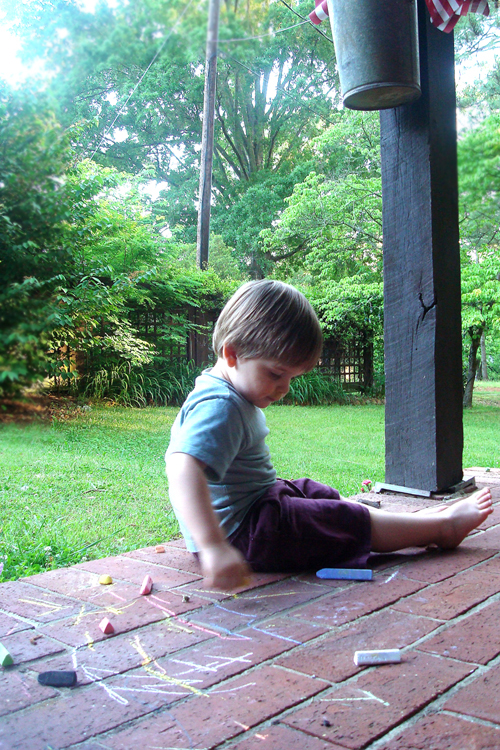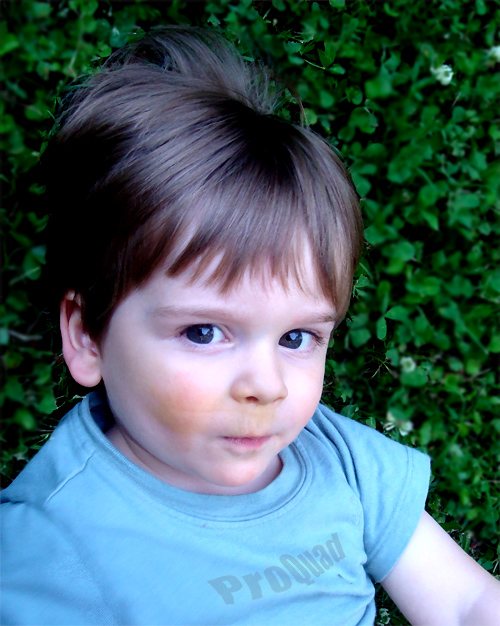 So Ben is injected with ProQuad on April 18, 2007 and immediately after he begins to change. Now I don’t mean to suggest that it was as dramatic as lights on, lights off, but over the next few months he flickered off and on, and then dimmed.
So Ben is injected with ProQuad on April 18, 2007 and immediately after he begins to change. Now I don’t mean to suggest that it was as dramatic as lights on, lights off, but over the next few months he flickered off and on, and then dimmed.
ProQuad is manufactured by Merck in West Point, PA at a plant that was found by the FDA to have failed to thoroughly investigate when vaccine batches did not meet specifications, even if those batches had been distributed. Some drug components were tainted, and the plant lacked proper procedures and safeguards to ensure purity. FDA conducted the inspections between November 26, 2007, and January 17, 2008.
ProQuad was taken off the market in April 2007, a week or so after Ben’s shots. Merck claims that the shortage of the vaccine — a combination of the company’s measles, mumps, rubella (MMR II) vaccine and its varicella-zoster (chickenpox shot ) licensed by the Food and Drug Administration (FDA) on September 6, 2005– is designed for children from 12 months to 12 years of age.
In terms of potential side effects, Dr. Henry Shinefield, a clinical professor of pediatrics and dermatology at the University of California, San Francisco School of Medicine and a consultant to Merck, doesn’t see any more danger than there is with the current two vaccines. “It is important that children and parents be made aware of every side effect,” he said. “The side effects with this vaccine are inline with what we see with other vaccines.”
At the time of FDA approval, there was evidence of a slightly increased risk of fever-related seizures among children who got the vaccine, but the vaccine was approved with a commitment from Merck to do a large post-marketing study to further understand this risk. Now, these studies are showing that children who get this vaccine are twice as likely to have seizures caused by high fevers.
The federal Advisory Committee on Immunization Practices (ACIP) made new recommendations on key vaccines at its February 2008 meeting in Atlanta, ACIP voted to withdraw the preferential recommendation for the measles, mumps, rubella, and varicella vaccine (MMRV, marketed by Merck & Co., Inc. as ProQuad) as the vaccine of choice for initial vaccination of infants. Researchers in the study looked at 43,000 children between the ages of 12 and 23 months who had been vaccinated with ProQuad and 315,000 who had received two separate MMR and chicken pox vaccines. They found that within seven to 10 days after vaccination, those given ProQuad suffered twice as many cases of fever followed by seizures as those given the separate shots. This amounted to one extra seizure per 2,000 children receiving ProQuad.
In absolute terms, nine of every 10,000 children receiving ProQuad suffered fever-related seizures, compared with four in 10,000 children in the dual vaccine group.
On February 27, 2008 the FDA accepted the new language to be used in ProQuad’s adverse reaction labeling. The Adverse Reactions section of the label has been revised to include two adverse events, encephalitis (Encephalitis is an acute inflammation of the brain. It can be caused by a bacterial infection such as bacterial meningitis spreading directly to the brain, or may be a complication of a current infectious disease such as measles. Certain parasitic or protozoal infestations can also cause encephalitis in people with compromised immune systems. Lyme disease may also cause encephalitis. Brain damage occurs as the inflamed brain pushes against the skull, and can lead to death) and epididymitis, (Epididymitis is a medical condition in which there is inflammation of the epididymis -a curved structure at the back of the testicle in which sperm matures and is stored) to reflect updated data from post-marketing surveillance reports. Information regarding the potential risk of febrile seizures following ProQuad® administration has also been added to this section.
ProQuad has about 10 times as much chickenpox virus as the standalone chickenpox shot. Roseola, which like chickenpox is a herpesvirus. Ben had Roseola prior to receiving ProQuad.
ProQuad cost about $124, sales of the vaccine amounted to over 2 billion dollars in revenue for Merck, during the 2 years it was on the market. That’s more than 200 million does sold. The National Vaccine Injury Compensation Program (VICP) was established in 1988 to compensate individuals and families of individuals injured by covered childhood vaccines. The compensation money has been funded by an excise tax of 75 cents on every purchased dose of covered vaccine. 200 million doses @ .75 each is $150,000,000.
In 1990, Merck & Co., manufacturer of the mumps-measles-rubella vaccine known as the MMR, made a significant but little-noticed change: It quadrupled the amount of mumps virus in the combination shot, from 5,000 to 20,000 units. Then in 2007 it reversed course, reducing the amount to 12,500 units. Neither the measles nor the rubella (German measles) component of the MMR was changed at all — each remained at 1,000 units throughout.
Merck also makes the single-component mumps shot, and in 1990 it also increased the potency of that shot by the same amount, from 5,000 to 20,000 units. But unlike the MMR shot, the standalone mumps shot’s potency was not scaled back in 2007. It remains at 20,000 units.
In 1990, Merck & Co., manufacturer of the mumps-measles-rubella vaccine known as the MMR, made a significant but little-noticed change: It quadrupled the amount of mumps virus in the combination shot, from 5,000 to 20,000 units. Then in 2007 it reversed course, reducing the amount to 12,500 units. Neither the measles nor the rubella (German measles) component of the MMR was changed at all — each remained at 1,000 units throughout.
Merck also makes the single-component mumps shot, and in 1990 it also increased the potency of that shot by the same amount, from 5,000 to 20,000 units. But unlike the MMR shot, the standalone mumps shot’s potency was not scaled back in 2007. It remains at 20,000 units.
The huge rise in autism cases began about the time the mumps component in the MMR was raised in 1990. One theory, dismissed by Merck and federal public health officials, is that viral interference between the components in the MMR could create a persistent sub-clinical measles infection in a subset of vulnerable children; and because the measles virus can cause brain damage, that could lead to autism.
A study released last week by the M.I.N.D. Institute at UC Davis reported that most of the fivefold increase in full-syndrome autism — from 9 in 10,000 children in 1990 to 44 in 10,000 children in 2000– is real and cannot be accounted for by broader categories or diagnostic substitution. And from 1990 to 2007, the mumps portion of the MMR was higher by roughly the same amount — quadruple.
Merck’s decision to cut back on the increase in the mumps vaccine also is surrounded by interesting timing. The cutback, in 2007, came at the same time Merck announced it was suspending its recently introduced, much-hyped four-in-one shot, ProQuad — the MMR with the chickenpox vaccine added to it. In suspending ProQuad, Merck cited a shortage of chickenpox vaccine; subsequently, a study showed ProQuad caused twice as many fever-induced seizures as separate MMR and chickenpox shots given at the same time, and a CDC advisory committee withdrew its preferential recommendation of the vaccine. Merck won’t say when ProQuad will return to the market.
Could ProQuad’s higher rate of measles rash and fever-induced seizures be a warning sign that something is amiss with the MMR itself, especially beginning in 1990 when Merck tinkered with the proportions of the components?
A related finding comes from a study funded by Merck. In 2005, the study reported that the four-in-one ProQuad shot — the MMR and chickenpox — was “generally well tolerated” and had a safety profile similar to the MMR and the chickenpox shot (also made by Merck and called Varivax) when given separately.
But there were a couple of interesting differences. First, “Measles-like rash and fever during days 5-12 were more common after the first dose of MMRV [ProQuad]” than after the MMR and Varivax given separately. The difference was substantial — 5.9 percent who got the MMRV had the rash and 27.7 percent had fever, compared to 1.9 percent with rash and 18.7 fever after getting separate shots. While that did not alarm the researchers, it could be a foreshadowing of the doubled rate of fever-induced seizures that was spotted after ProQuad was approved.
Second, even though the new element in ProQuad was the chickenpox portion, something new and unexpected was also going on with the mumps and measles components. “Geometric mean titers to measles and mumps were significantly higher after 1 dose of MMRV than after administration” of MMR and Varivax separately, according to the study’s summary. Later, the authors state: “This suggests that the measles and mumps virus replication is greater after MMRV than it is” after the MMR and Varivax given separately.
In non-scientific language, it looks like the addition of another live virus — chickenpox — potentiated the measles and mumps components: It kicked both viruses into higher gear and they replicated at rates higher than in the MMR.
At the same time, the researchers observed a greater incidence of measles-like rash, and fever, in those who got ProQuad. Were the increased measles and mumps viruses interacting in some unexpected and potentially dangerous way?
Then, for whatever reason, sometime between February and December of last year Merck reduced the mumps component of the MMR from 20,000 units to 12,500 while leaving the standalone mumps shot as it was. During that same period, it decided to suspend production of ProQuad. In April 2007, it announced the suspension, and said no more would be available after July. Then in early 2008, Merck’s study showing the doubled risk of seizures in ProQuad was unveiled and the CDC withdrew its recommendation.
And just last year, Merck said it would stop making the individual MMR component shots including, of course, the mumps shot. That leaves the MMR as the only vaccine in town, and it means there will no longer be a mumps vaccine formulation on the market with the dose the MMR contained from 1990 to 2007.
Merck acknowledges the three viruses can indeed interact to affect a child’s immune system, although in ways it says are not harmful.
A Merck scientist publicly discussed the interference issue at a CDC meeting in 2004, the year before ProQuad was approved, according to agency minutes. Dr. Florian Schodel “confirmed the possibility that the chickenpox virus component of ProQuad was causing a local immune suppression and an increase in measles virus replication. … The current hypothesis is that the varicella and measles virus are co-infecting the same or proximate areas of the body and engaging in a specific interaction, but how that works is as yet unknown.
“He said the interference appeared to involve only the chickenpox and measles viruses – ‘there is no such effect for the mumps or rubella vaccines administered locally at the same time.’”
Yet based on Merck’s own 2005 study cited above, ProQuad triggers an increase in mumps virus replication, too. Live viruses in ProQuad seem to be behaving in ways “as yet unknown” that cause immune suppression, co-infection, interaction and increased replication. Even without ProQuad on the market, interaction between the MMR components and the chickenpox virus remains a possibility. The CDC started recommending the chickenpox shot in the mid-1990s at the same 12-month well-baby visit as the MMR.
That suggests the pattern highlighted by ProQuad could be at work through the increased mumps component of the MMR and the addition of chickenpox to the childhood immunization schedule in the mid-1990s. The lesson could be that combining live viruses, and then increasing them or adding new ones, is inherently dangerous, especially when invasion of the brain by one of them “is not an uncommon event.”
Two additional points worth noting: After the increase in 1990 and decrease in 2007, there is still more than twice as much mumps virus in the MMR as there was in 1990.
The changes in the mumps virus component of the MMR serves as a potent reminder of something else: MMR is not one thing but three different exposures. And over the period 1980-2009 the MMR has changed significantly at least twice, making epidemiological studies even more difficult to interpret.
Gathered from Dan Olmsted is Editor of Age of Autism.
ProQuad has been taken off the market, coincidentally within a week or two after Ben’s shot. The manufacturer of ProQuad, Merck, has yet to reintroduce the vaccine back to the marketplace, but if they do the FDA has made a requirement in 2008 that ProQuad list as an adverse reaction, siezures and encephalitis (swelling of the brain), both of which my son developed after his vaccine.
Ben’s neurologist feels Ben’s encephalitis is caused by a viral infection, most likley the measles. But who knows?
What I do know is that ProQuad generated nearly 2 billion dollars for Merck the two years it was on the market. It was their second biggest bread winner, just behind Gardasil.
Just prior to Merck pulling ProQuad the FDA inspected their plant in West Point, PA and issued Merck a warning that Merck officials didn’t thoroughly investigate when vaccine batches failed to meet specifications, even if those batches had been distributed. Some drug components were tainted, and the plant lacked proper procedures and safeguards to ensure purity.
The federal Advisory Committee on Immunization Practices (ACIP) made new recommendations on key vaccines at its February 2008 meeting in Atlanta, ACIP voted to withdraw the preferential recommendation for the measles, mumps, rubella, and varicella vaccine (MMRV, marketed by Merck & Co., Inc. as ProQuad) as the vaccine of choice for initial vaccination of infants.
On October 1, 1988, the National Childhood Vaccine Injury Act of 1986 (Public Law 99-660) created the National Vaccine Injury Compensation Program (VICP). The VICP was established to ensure an adequate supply of vaccines, stabilize vaccine costs, and establish and maintain an accessible and efficient forum for individuals found to be injured by certain vaccines. The VICP is a no-fault alternative to the traditional tort system for resolving vaccine injury claims that provides compensation to people found to be injured by certain vaccines. The U. S. Court of Federal Claims decides who will be paid.
As of January, 2009, 12,850 cases have been filed with the National Vaccine Injury Compensation Program (VICP) , 5,535 representing autism cases. Of the total, 6,979 have been adjudicated, with 2,260 being compensated. Claims arising from vaccinations given prior to October 1, 1988, were paid from general appropriations. Petitioners filed 4,259 pre-1988 claims, with 1,187 being compensated. Over 900 million dollars of general revenue was paid for pre-October 1988 cases, including attorneys’ fees at a statutorily capped level. Payments for post- October 1988 cases come from a trust fund supported by an excise tax on each dose of vaccine that is covered by the Program. Thus far, 8,591 post-1988 claims have been filed, with 1,071 being compensated. Over 939 million dollars has been paid in compensation from the trust fund for the post- 1988 cases, including attorneys’ fees and costs. There is currently nearly 3 billion dollars in the trust fund. There is a wide range of awards depending on the severity of injury, with the highest award currently being $9.1 million in present dollars.
2008 there were 144 awards totaling $83,743,524.93 (avg. over a half million dollars per award) 5 million dollars in attorney fees were paid, in the 70 dismissed cases, the court paid out over 2 million in attorney fees (about $30,000 per case.
See http://www.hrsa.gov/vaccinecompensation for more detailed statistical information regarding the VICP.
Lastly, just the other day I discovered on the the Vaccine Adverse Event Reporting System (VAERS) Web site that ProQuad has had two deaths attributed to the vaccine. Both were submitted on November 3rd and entered in on November 4th. (VAERS ID 331196 & 331194 .
ProQuad was removed from the market back in May of 2007. A year and a half later two deaths show up on the VAERS website. This reminds me of the April 18, 2006 article in AoA about ProQuad’s study that determined that there were twice the number of children with seizures than those receiving the MMR and the chicken pox vaccine separately. Apparently in the Washington state capital of Olympia, a couple of injuries resulting from the administration of the vaccine back in January 2001 and October 2002. The injuries were not reported to the FDA until 2006, 3 months after the FDA approved ProQuad and after a reporter asked if the FDA had them. See the comments section for more about this AoA report. (to find all the Pox articles by AoA editor Dan Olmsted click here and scroll down to April 2006)
If anyone knows how to get information on the two deaths listed in VAERS please email me at bensmyson@gmail.com, obviously both did not die in November of 2008.
Also look for the post on this blog regarding the link between Varicella-Zoster virus also known as Herpes Zoster and Acquired Childhood Aphasia (ACA) which is a language impairment resulting from an unspecified brain damage. This brain damage can have different causes, such as head trauma, tumors, cerebrovascular accidents, encephalitis, or seizure disorders. Most, but not all authors state that ACA is preceded by a period of normal language development.

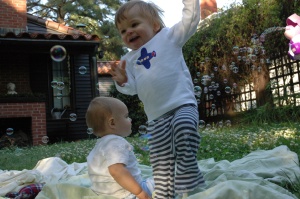 Right after Ben’s first birthday, around the first of May, we baby-sat his cousin, our nephew, for a week while my sister and her husband took a vacation. Ben and his cousin are one month apart and we saw it as an opportunity to have the two, one year olds, spend time together and perhaps build a bond between them that would last a lifetime. Ben didn’t like it. His cousin didn’t like it either, he wanted mommy and daddy, not us. Almost immediately Ben became irritated at his cousin’s tearful cries for attention. His irritation soon became violent. He smacked his cousin every chance he got. We responded with putting Ben in time out for the first time in his young life. Needless to say Ben hated it but we figured he can’t be allowed to act this way, even though I mostly played it off as boys will be boys.
Right after Ben’s first birthday, around the first of May, we baby-sat his cousin, our nephew, for a week while my sister and her husband took a vacation. Ben and his cousin are one month apart and we saw it as an opportunity to have the two, one year olds, spend time together and perhaps build a bond between them that would last a lifetime. Ben didn’t like it. His cousin didn’t like it either, he wanted mommy and daddy, not us. Almost immediately Ben became irritated at his cousin’s tearful cries for attention. His irritation soon became violent. He smacked his cousin every chance he got. We responded with putting Ben in time out for the first time in his young life. Needless to say Ben hated it but we figured he can’t be allowed to act this way, even though I mostly played it off as boys will be boys.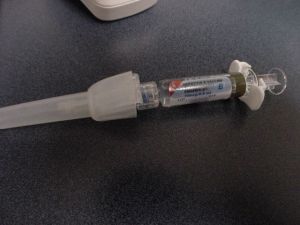 Prior to Ben being born his mom spent a lot of time researching how to deliver and raise a healthy baby. One of her concerns was the Hepatitis B vaccine being administered so early. She expressed those concerns with the doctor and was assured that the shot could be delayed with no problem.
Prior to Ben being born his mom spent a lot of time researching how to deliver and raise a healthy baby. One of her concerns was the Hepatitis B vaccine being administered so early. She expressed those concerns with the doctor and was assured that the shot could be delayed with no problem.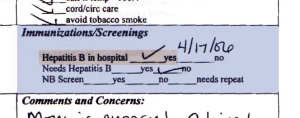


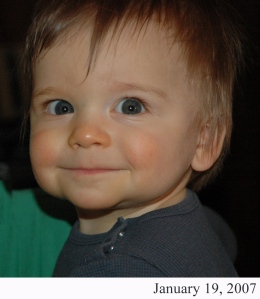 Right after Christmas Ben started feeling punk. The in-laws were in town, the house was still full of wrapping paper and toys that go beep, whirrrrr and zoink. But Ben had a fever, and the fever kept getting worse. Since it was the holidays the pediatrician’s office was closed and the calls were forwarded to the UNC hospital phone bank 30 miles away in Chapel Hill. The dial-a-nurse kept reassuring us every time we called that Ben would be alright, that children can endure high fevers and as long as he was drinking liquids and comfortable a 104 fever is nothing to be concerned about. She also said not to worry unless his fever gets over 105. When it got to be 105, we called again and again we were told not to worry, kids can take it.
Right after Christmas Ben started feeling punk. The in-laws were in town, the house was still full of wrapping paper and toys that go beep, whirrrrr and zoink. But Ben had a fever, and the fever kept getting worse. Since it was the holidays the pediatrician’s office was closed and the calls were forwarded to the UNC hospital phone bank 30 miles away in Chapel Hill. The dial-a-nurse kept reassuring us every time we called that Ben would be alright, that children can endure high fevers and as long as he was drinking liquids and comfortable a 104 fever is nothing to be concerned about. She also said not to worry unless his fever gets over 105. When it got to be 105, we called again and again we were told not to worry, kids can take it.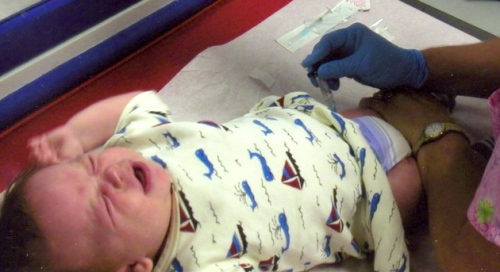
 In November I began listening to my wife about her concerns for Ben. She had been extremely depressed that no one is listening to her. Me in particular. I had one time told her the story of a dog that I raised and how he backslid, that it was nothing but rebellion, ego, establishing his spot in the household. Nothing a little time wouldn’t cure. Words she was hearing from the doctors.
In November I began listening to my wife about her concerns for Ben. She had been extremely depressed that no one is listening to her. Me in particular. I had one time told her the story of a dog that I raised and how he backslid, that it was nothing but rebellion, ego, establishing his spot in the household. Nothing a little time wouldn’t cure. Words she was hearing from the doctors.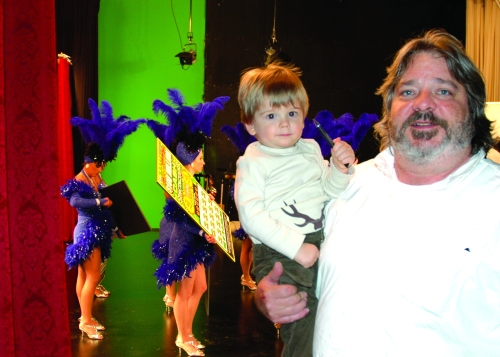
 On November 25, 2007, I sent out an SOS email to just about anybody that was located within 60 miles and was a professional organization with a title that began or ended with the word autism. I got several responses. Now remember I didn’t know squat about anything when it comes to autism, but I was extremely scared and anxious to get help right away. My son had been slipping away and I was just becoming aware of it.
On November 25, 2007, I sent out an SOS email to just about anybody that was located within 60 miles and was a professional organization with a title that began or ended with the word autism. I got several responses. Now remember I didn’t know squat about anything when it comes to autism, but I was extremely scared and anxious to get help right away. My son had been slipping away and I was just becoming aware of it. So Ben is injected with ProQuad on April 18, 2007 and immediately after he begins to change. Now I don’t mean to suggest that it was as dramatic as lights on, lights off, but over the next few months he flickered off and on, and then dimmed.
So Ben is injected with ProQuad on April 18, 2007 and immediately after he begins to change. Now I don’t mean to suggest that it was as dramatic as lights on, lights off, but over the next few months he flickered off and on, and then dimmed.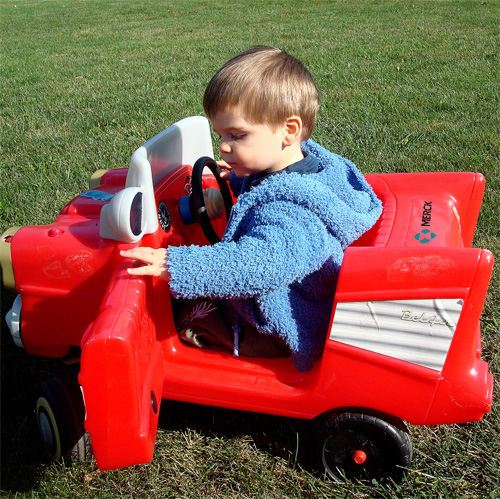 I think back to my high school science education, 2 years of biology (failed and repeated) and the in the five years I was in college I some how managed to postpone any lab sciences. So my understanding of anything that has to do with biological science or chemistry is somewhat limited to my own personal experiences with doctors and hospitals… oh yeah and my mother the nurse, hospice nurse, expert in things that can kill you.
I think back to my high school science education, 2 years of biology (failed and repeated) and the in the five years I was in college I some how managed to postpone any lab sciences. So my understanding of anything that has to do with biological science or chemistry is somewhat limited to my own personal experiences with doctors and hospitals… oh yeah and my mother the nurse, hospice nurse, expert in things that can kill you.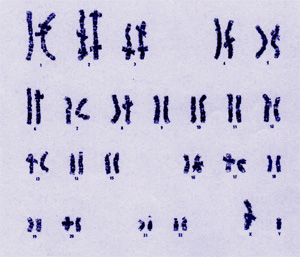

 For the past 18 months Ben’s breakfast has been yogurt with fish oil, and a super dose of vitamins and minerals. We have just, in the past couple of months, introduced a toxin cleanser and lysine as well. The diet is under the advisement of his doctor and seems to help. We have not stopped it to see if we notice changes.
For the past 18 months Ben’s breakfast has been yogurt with fish oil, and a super dose of vitamins and minerals. We have just, in the past couple of months, introduced a toxin cleanser and lysine as well. The diet is under the advisement of his doctor and seems to help. We have not stopped it to see if we notice changes.